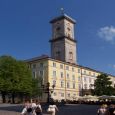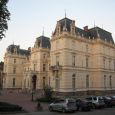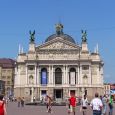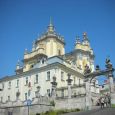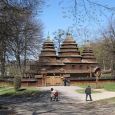Lviv
Advertisement
By Air
Interbellum Lviv also was a major center of the Polish Air Force with the Sixth Air Regiment located there. The Regiment was based at the airport in Lviv's suburb of Skniłów (today Ukrainian: Sknyliv) opened in 1924. Sknyliv Airport is now named Lviv International Airport (LWO), and is located 6 km from the city centre.A new terminal and other improvements are being under a $200 million expansion project in preparation for the 2012 UEFA European Football Championships.
By Train
Modern Lviv remains a hub on which nine railways converge providing local and international services.Lviv railway is one of the oldest in Ukraine. The first train arrived to Lviv on 4 November 1861.The main Lviv Railway Station, designed by Władysław Sadłowski, was built in 1904 and was considered one of the best in Europe from both the architectural and the technical aspects.Currently several trains cross the nearby Polish–Ukrainian border (mostly via Przemyśl in Poland). There are good connections to Slovakia (Košice) and Hungary (Budapest). Many routes have overnight trains with sleeping compartments.Lviv railway is often called a main gateway from Ukraine to Europe although buses are often a cheaper and more convenient way of entering the "Schengen" countries.
By Bus
The public bus network is mainly represented by mini-buses.Large buses are inconvenient due to the traffic conditions of the narrow streets in the central historical part of the city. People call these mini-buses marshrutka (route taxi) and they operate over the whole city. Marshrutkas have no fixed stops and stop not only at bus stops but in other places where it is allowed. The marshrutkas are cheap, fast and mostly reliable.This kind of transport is so popular and convenient that mini-buses are often overcrowded during rush hour. Marshrutkas also run on suburban lines to most suburbs and nearby towns, e.g. to Shehyni at the Polish border.There are also two bus routes in Lviv.The price (as of February 2010) of a one-way single ride in a marshrutka within the city of Lviv is 1.75 UAH regardless of the distance traveled. No tickets are provided and the money is paid to the driver. The price (February 2010) of a ride on a city-bus is 1.00 UAH.
By Trolleybuses
The city centre tramway lines were replaced with trolleybuses on 27 November 1952.New lines were opened to the blocks of flats at the city outskirts.The network now runs about 100 trolleybuses–mostly of the 1980s Skoda 14Tr and LAZ 52522.In 2006–2008 11 modern low-floor trolleybuses (LAZ E183) built by the Lviv Bus Factory were purchased.The price (as of February 2010) of a tram/trolleybus ticket is 1.00 UAH (reduced fare ticket is 0.50 UAH, e.g. for students).The ticket may be purchased from the driver.
Advertisement
Market Square
The Rynok Square in Lviv is a central square of the city of Lviv, Ukraine.It was planned in the second half of the 14th century, following granting city rights by Polish king Casimir III, who annexed Red Ruthenia.The king ordered Lviv to be moved more to the south, where a new city was built to the plan of a traditional European settlement: a central square surrounded by living quarters and fortifications.Old, Ruthenian Lviv had become a suburb of the new city.Around the square, there are 44 tenement houses, which represent several architectural styles, from Renaissance to Modernism. In the four corners, there are fountains wells from 1793, probably designed by Hartman Witwer.The sculptures represent four Greek mythological figures: Neptune, Diana, Amphitrite and Adonis.In front of the Town Hall, there was a pillory.In 1998 the Market Place, together with the historic city center of Lviv, was recognized as a UNESCO world heritage site.
Black House
Is a remarkable Renaissance building on the Lviv Market Square, in the city of Lviv, Ukraine.It was built for Italian tax-collector Tomaso Alberti in 1577.The architect was probably Piotr Krasowski.The Lviv Historical Museum has been housed in the Black House since 1926.The facade is lined with sandstone which has darkened over the years to blackish brown.The front exhibits some fine decorative ornamentation.Jan Lorencowicz, having acquired the house in 1596, added another storey and opened one of the town's first pharmacies on the ground floor.The uppermost storey was added in 1884.
Korniakt Palace
On Market Square in Lviv is a prime example of the royal kamienica, or townhouse.The fabric of the palace is of various dates.It was originally built by architect Piotr Barbon for merchant Konstanty Korniakt, a champion of Greek Orthodoxy and co-founder of the Lviv Dormition Brotherhood. Construction of this severely elegant Renaissance palazzo was completed in 1580.In 1908, the Sobieski Palace became home to the Jan III museum.It is now part of the Lviv History Museum.The royal chambers are used for exhibiting Rococo furniture and clocks, a collection of medallions,and precious silverware.
Latin Cathedral
Is located in city's Old Town, in the south western corner of market square.The first church built on this site was a small wooden Roman Catholic church dedicated to the Holy Trinity, built in 1344 and lost in a fire six years later. In 1360 the king Casimir III of Poland founded the construction of the present day church, built in Gothic style, for a cathedral of the newly created Latin diocese. The church was consecrated in 1405 and the parish was moved here from the church of Mary of Snow. In 1412 the seat of the bishop was transferred from Halych. Construction work continued throughout the 15th century and in 1481 the Cathedral was finally consecrated.
Potocki Palace
The Potocki Palace in Lviv was built in the 1880s as an urban seat of the Potocki aristocratic family. No cost was spared to make it the grandest nobleman's residence in the city.In the 2000s the President of Ukraine appropriated the palace as one of his residences. Some of its architectural motifs were borrowed by the next-door exhibition hall (inaugurated in 1996).The French architect Louis de Verny elaborated all of Beaux-Arts stylisic devices to produce a hypertrophied imitation of a French hôtel particulier. An open, parklike setting was scored to give the mansion a sense of depth.
Information not available
Information not available
Advertisement

